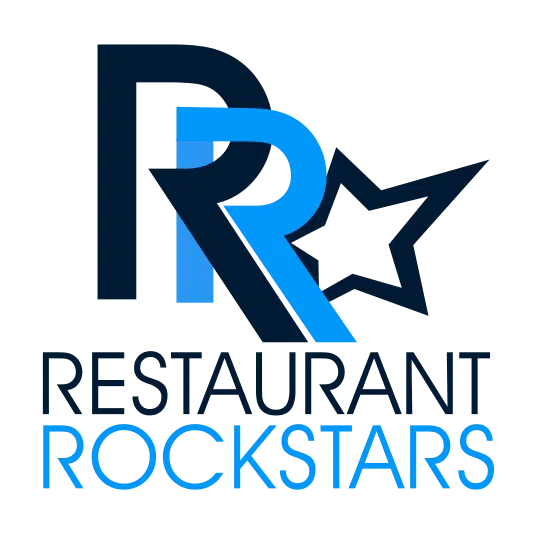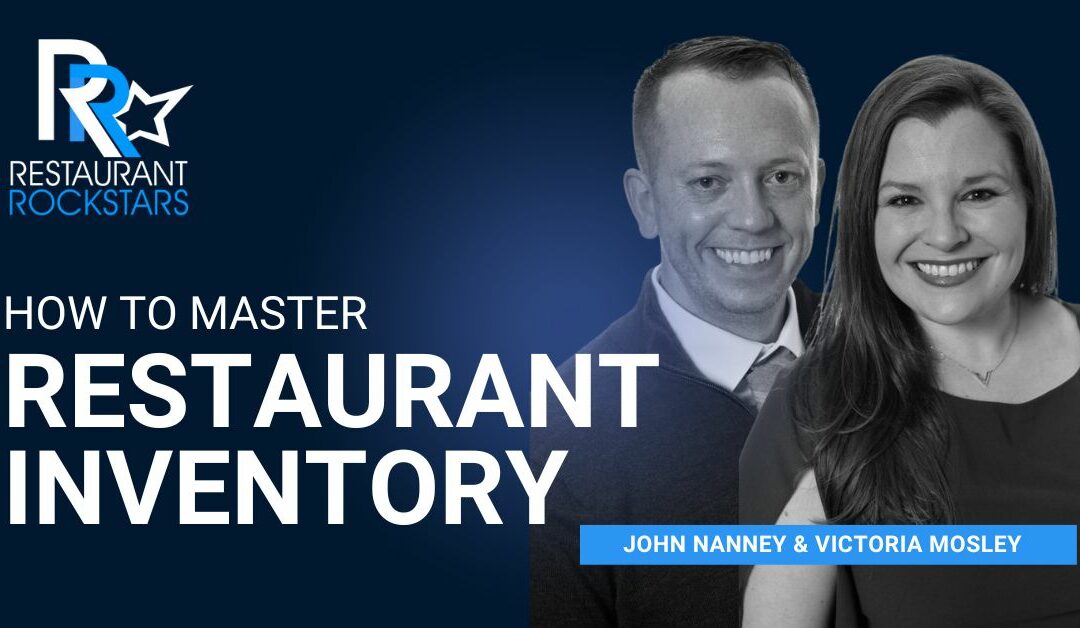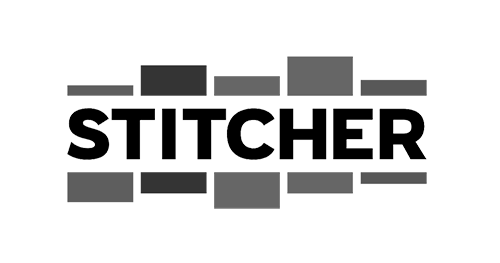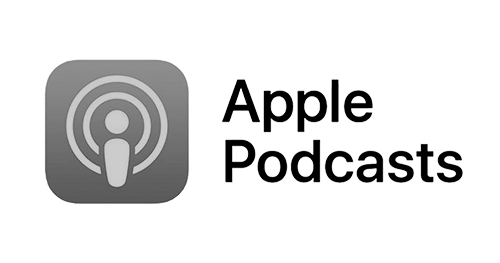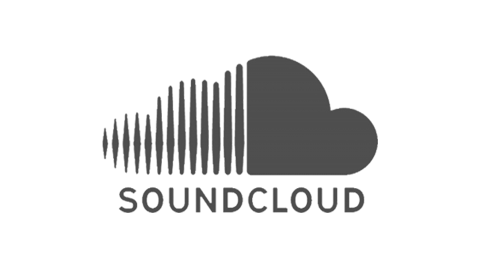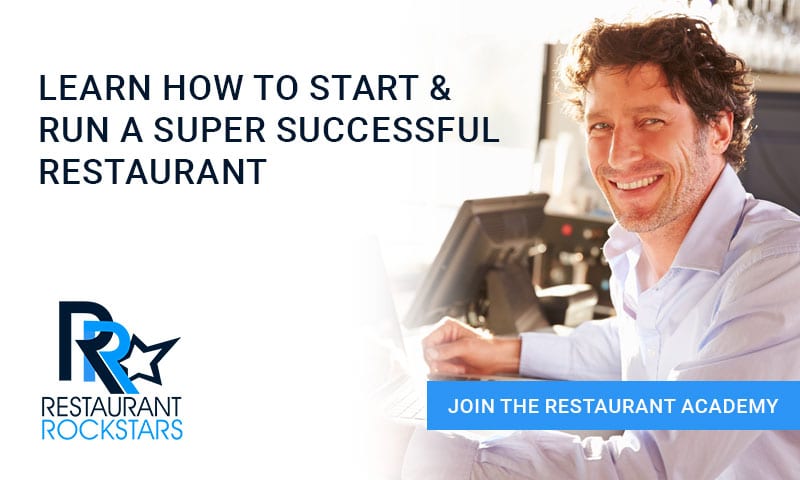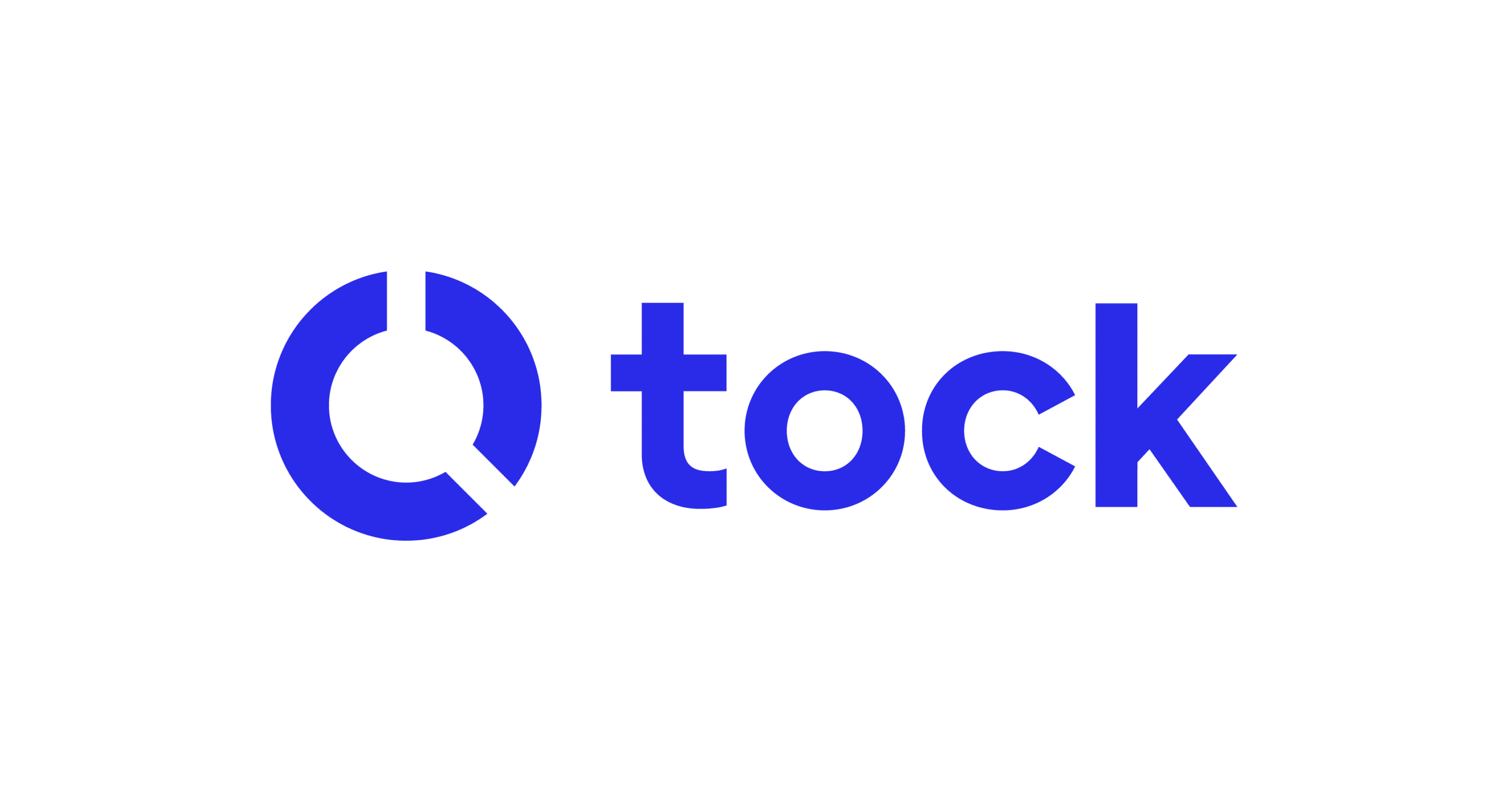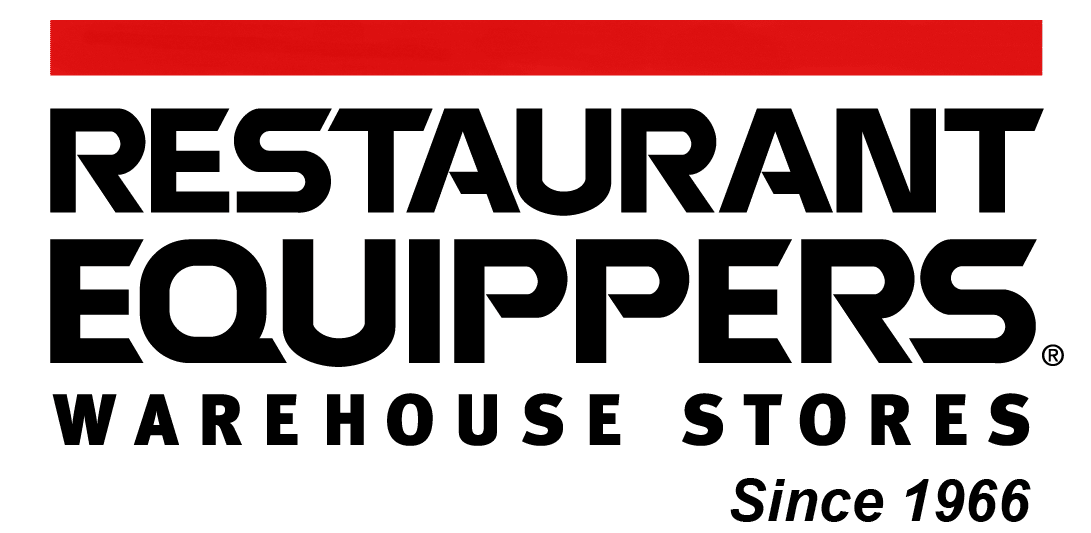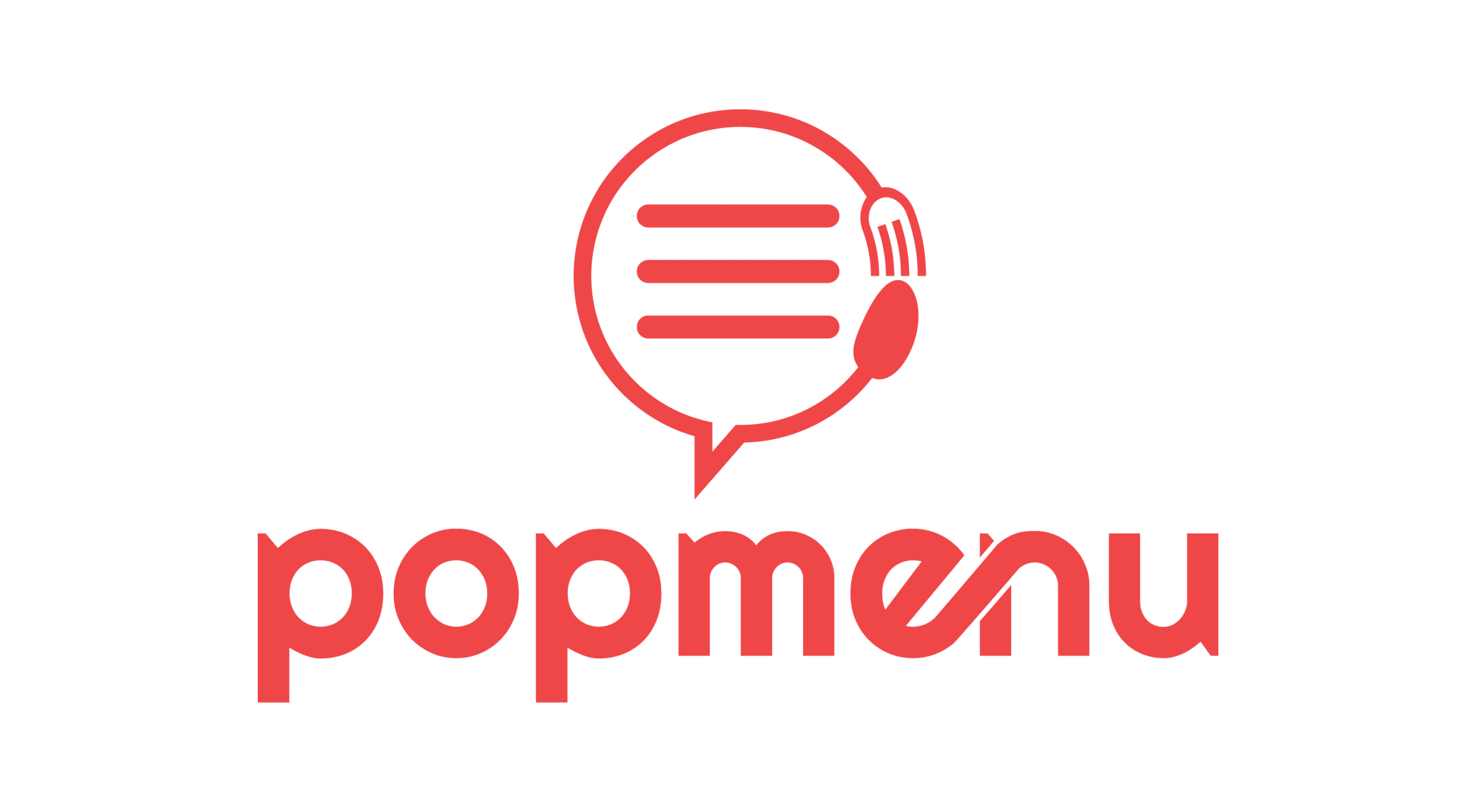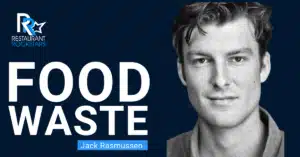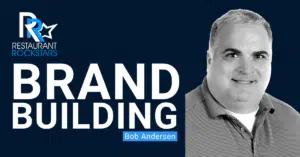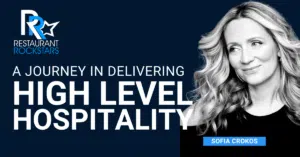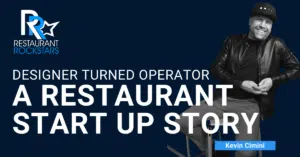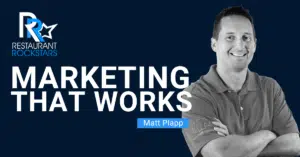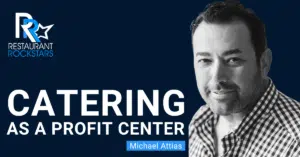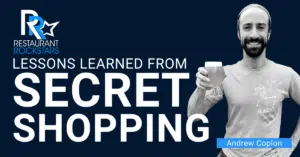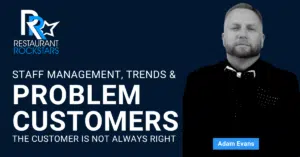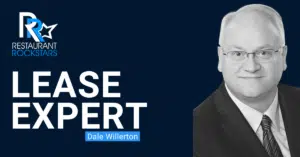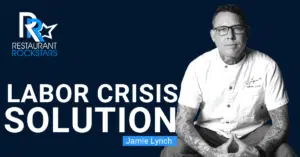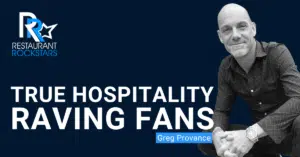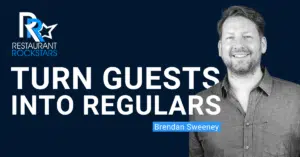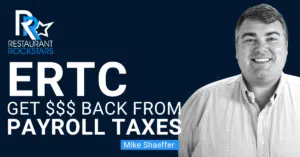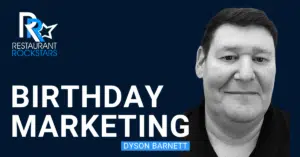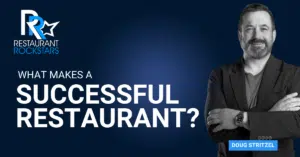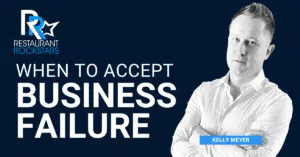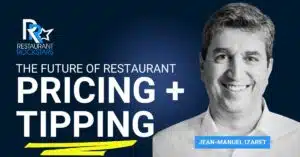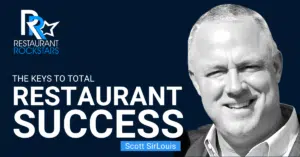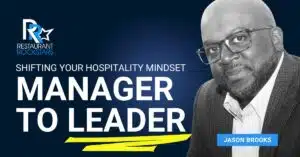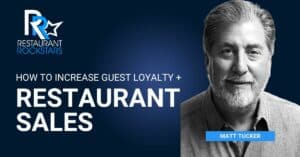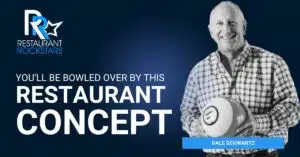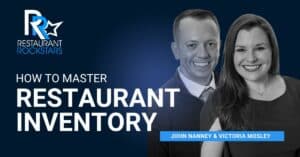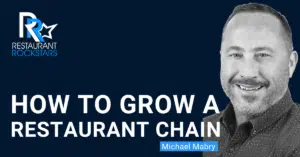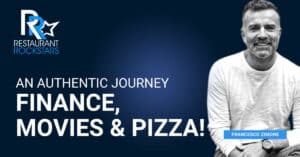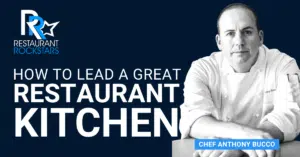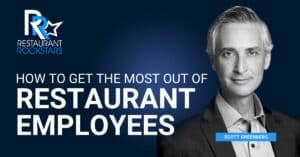Restaurant Rockstars Episode 378
Stocked & Stirred: How to Master Restaurant Inventory
LISTEN HERE OR ON YOUR FAVORITE PODCAST PLAYER
Your restaurant inventory represents thousands if not tens of thousands of dollars of food and beverage sitting in your business at any given time.
With so much opportunity for waste, spoilage, or loss, you really need to understand and manage all that value.
When I coach restaurants, I tell them Not taking inventory is like leaving hundred-dollar bills all over your restaurant. You just wouldn’t do that, so don’t leave your restaurant inventory to chance
In this episode of the Restaurant Rockstars Podcast, I’m speaking with Victoria Mosley and John Nanny, from Sculpture Hospitality, a tech platform that systemizes both your food and beverage restaurant inventory. Their people are former restaurant owners, GMs and other industry experts who are a fresh set of eyes that provide a hands-on approach to improving your business.
Listen as Victoria and John explain how to master restaurant inventory including:
- Today’s biggest restaurant challenges and solutions
- The importance of taking inventory and not just placing orders
- How restaurants can leverage their purchase and sales data to increase sales, reduce losses and improve overall efficiency
- Where valuable goods on hand may be hiding without proper storage procedures
- The optimum frequency of restaurant inventory
- How to easily account for prepped foods, pars and goods in process
And best of all how Sculpture Hospitality provides customized restaurant inventory solutions that work for your business and budget from full-service to sharing responsibility to do it yourself service.
Sculpture Hospitality is offering my listeners a free, no-obligation consultation with an expert at www.sculpturehospitality.com/rockstar
Roger
Connect with our guest:
https://www.instagram.com/sculpture.hospitality/
https://twitter.com/sculptureHQ
https://www.facebook.com/sculpturehospitality
https://www.linkedin.com/company/sculpturehospitality
https://www.youtube.com/channel/UCMzz-FD7WmK2W4FGI41O-BQ
FREE RESOURCE
Don’t miss this episode, get my FREE “Top 3 Ways You’re Killing Your Restaurant Profits and a bonus at www.restaurantrockstars.com/profits then go out there and Rock YOUR Restaurant!
Welcome back to the podcast. Thanks again for joining me. This episode is all about one of those foundational elements of running a really efficient and profitable restaurant. I’m talking all about inventory. Now we’re going to talk about this in this episode, but there are many operators out there that Just think it’s a laborious process or think that taking inventory is just about counting, , what’s missing and placing the order for that week, but reality is that inventory is about calculating the true value of your food and beverage items that are on hand in your operation at any given point in time.
And it’s a really important process in order to accurately calculate your food and beverage costs. So with me today, , John Nanny and Victoria Mosley are with Sculpture Hospitality, and this is a platform that specializes in hospitality industry inventory.
They are former operators, , former general managers, people that really understand the process and , really understand how to run a profitable restaurant,
so you’re not going to want to miss this episode. We’ll Thank you so much to our sponsors this week. Thank you to our audience for tuning in. Now, on with the episode.
You’re tuned in to the Restaurant Rockstars Podcast. Powerful ideas to rock your restaurant. Here’s your host, Roger Beaudoin.
Running a restaurant is a marathon of management. You’re constantly managing customers, employees, vendors, menus, marketing, and the list goes on. But don’t forget the essential element, managing inventory, a crucial factor that can make or break your success. Listen, Sculpture Hospitality is the secret ingredient you’ve been missing.
They don’t just manage your food and beverage inventory, they blend expertise with technology. They take your inventory, sales, purchases, everything, and transform it into a roadmap for your restaurant’s success, painting a vivid picture of your profitability. Their range of service options will meet your needs and your budget.
Are you looking for a hands on, full service solution using one of their inventory experts? Or do you prefer sharing inventory responsibilities? Or even a self service option? Sculpture Hospitality Services are like a customized menu designed to your operation. Take charge of your bar or restaurant inventory today. Get a free, no obligation, inventory consultation from Sculpture Hospitality.
Visit SculptureHospitality.com/rockstar and discover their inventory solution that matches your needs, your budget, and your success.
Rockstars, this year, give your team the gift of PopMenu AI Answering, a simple solution for phones ringing off the hook. AI Answering handles calls 24 7, 365 days a year, so your staff can focus on in person guests.
Customize your greetings and responses. Answer common questions. promote specials and events, and send follow up links to ordering and reservations. AI answering handles it all, while escalating more complex conversations back to your team. Now, never miss another tasty revenue opportunity. PopMenu is the marketing technology platform designed to make growing your restaurant easy.
Discover more A. I. restaurant tools that turn your to do list into an already done list. Request a demo today and my listeners for a limited time will get $100 off their first month, plus lock in one unchanging monthly rate. Go now to popmenu.com/rockstars. Again, get $100 off your first month at popmenu.com/rockstars.
Welcome back everyone to the Restaurant Rockstars podcast. So glad to have you here, Victoria, John, how are you? I’m fantastic. How are you? Excellent. I love meeting new people in the hospitality space and I’d love to hear your backstory. So tell us how you got started in this business.
Victoria, do you want to kick off with your your background?
Sure. I had my first server job when I was 16 at a local restaurant in a very small town in Alabama with some bartending and serving and management experience smattered through college at the University of Alabama. And then when I really Started with a more professional organized situation was with Mellow Mushroom.
It’s a pizza and craft beer place. So that was my first iteration of a job that actually used inventory after almost. Probably close to 10 years of having been a part of the industry. So that was a real eye opener for me going from a really small situation to, to looking at it more as a as a business, instead of just, the service aspect of it.
So you worked there for a while, and you mentioned you had different roles, you were behind the bar, you were a server, you did some management as well, so that sort of immersed you in the importance of inventory. We’re going to talk all about inventory, but you obviously have a passion for the business because you’re still here, right?
Yeah.
And, it’s really interesting to see how the ebbs and flows go between just being a server and being able to detach yourself from a lot of the responsibility. And then, as so often happens in smaller operations, especially in hospitality, a position for management opens up and you’ve shown up reliably enough to be handed the keys, but not necessarily have all of the knowledge and information that you need to effectively run a location.
So it has certainly been a Learning while on the job process, as I know a lot of people in hospitality kind of experience, so yeah.
That’s a great introduction to your history in hospitality. Thanks, Victoria. How about you, John? Tell us about your
story. So I wanted actually Tori to go first.
She has an extensive background in hospitality. My background’s just a little bit different. I actually aside from, waiting at a place called Gateway Fun Park in small town Illinois, I was a teacher in the trades for eight years before I came in to Sculpture Hospitality which is really where my focus has been.
But since joining the organization I spent I think five years auditing and working alongside Victoria here almost as a mentor to learn not only the industry but the ins and outs of our system and how everything
works. Terrific. And now you’re quite a qualified team, and there is expertise behind not just the platform itself, but there are lots of hospitality professionals that work for Sculpture Hospitality as well, as I understand.
Absolutely. That’s certainly helpful when you can walk the walk, talk the talk, and really help out, potential new clients to let them understand the platform, how it works and the onboarding process. We’re going to get into all of that. But why don’t you tell us what your roles are now with Sculpture Hospitality.
Yeah, I’d be more than happy to kick that off. My role is the Chief Information Officer. And, aside from the infrastructure and the technical side of everything, my focus in my day to day is really taking All of our technologies and making sure that they fit our industry, by working through many subject matter experts and all of our franchises in the field, just so that what we are providing can not only add value, but just assist in the many facets of hospitality.
Make sure that operationally, everything that we’re doing benefits our clients and customers. Okay.
Excellent. Thank you. How about you, Victoria? What’s your role?
I am on the implementation side of everything that John just said. I oversee our local markets and we have a few remote.
So I assist in making sure that all the local area managers have the tools that they need to be able to perform their jobs properly. And then when John comes up with new things, I make sure that we test it thoroughly before we expect anybody else to jump in.
Fantastic. Thanks for answering that. Hospitality is constantly changing and shifting.
There are foundational elements, of course, about delivering amazing service to guests, and obviously there’s foundational financials involved. But there’s a lot of challenges in this business. So besides technology, what do you both see as trends that are happening now? Maybe that comes from, feedback you’re getting from current clients and customers, or maybe it’s just, what you read in the trades.
But what do you see trending right now when You’re an operator and you want to keep your finger on the pulse of what’s going on out there.
As the person who’s typically out in the field, I’ll jump in on that one first. I think, and it’s always been a challenge, but I think it’s been highlighted in the past few years.
Labor is always going to be one of the greatest hindrances to running a good and smooth operation. You can have the best of intentions in hiring, training, a very well laid out situation and it just takes one bad day for the kitchen to fall apart, for you to not have any servers, so any sort of labor related thing, I would say is probably in the day to day, the most obvious challenge because that is specifically the people who are in the building, right? So it’s. It’s hard to overlook that as
a problem. Let me ask you, let’s take that a step further. Are you seeing people returning to the restaurant industry and hospitality in general?
I know there was an exodus just post pandemic. So many operators across the country had really struggled with, not just finding good people, but keeping their existing good people. Are you seeing that turnaround at all, or are operators still struggling?
I would say it’s a little bit of both.
With some of the people who were long term. who, who really knew how to run the business are starting to come back for, selective shifts, not necessarily that being their primary, but coming back to the place that had been their home for so long to, to help out because it is a challenge, but then I also see a lot of training and a lot of very much more fresh faces.
I think that the general age range of the average staff has started to trend towards the younger. Because the people who’ve been doing it for a long time did find other opportunities during that down time. And, they may come in for a high money shift, but they’re not there for that 10 a. m. Monday morning opening shift
anymore. I love to get the point across that, so many young people do start in this industry and a lot of them do use it as a skill. stepping stone to somewhere else. But this is one industry where you really don’t need a formal education to go to the top of the industry.
You can start out at the very bottom of a restaurant, whether that’s in the dish pit or as a fry cook, and you can literally own your own restaurant someday. And my restaurants were a testament to that. And it’s all about, that passion, discovering this is a great industry. It’s a fun business.
The people that work in it are really dynamic and stuff. And then learning as much as you can and applying yourself. So I really like to get that point across and I’m sure you’ve seen that as well. John, why don’t you give us your perspective? Yeah, I’m more than happy to.
It’s actually parallels directly with Victoria.
The, one of the things that I’ve seen the most is, um, there are a lot of applications out there. A lot of different systems that, I should say pre COVID, there are a lot of systems out there to automate things and increase efficiencies. With COVID, things changed. People shut down. People went back to the basics.
They cut out what they could just to survive. Everyone went into survival mode. Now post COVID, or whatever you want to call it now these days we are, the state we’re at, we have a lot of technologies that were in place that aren’t being leveraged, and there aren’t people there to use them to do it.
As Victoria was saying, they’re A lot of new hires, they’re just trying to get people out to be able to serve and do different things. And so from that, we’re seeing a lot of different industries growing in the positive side to supplement the places where people can’t hire. And, I don’t need to get into the sculpture just yet, but that’s one of the reasons why we are, we’re seeing successes.
And changes in our service patterns, this is again, this is through my view in our service patterns of what we provide clients because they’re using us to supplement employees or different levels of management because they can’t hire for that. And it’s been really, it’s been very interesting to see where things are going, where these
trends are going.
It’s really good to know that your platform does create efficiencies in a restaurant, and it’s going to be a solution to that challenge. Let’s go full circle, and let’s talk about inventory in general, because it is such an important process. And in my experience over the years, I speak across the country quite a bit at different food shows, and specifically for large food service suppliers, and I hear constantly that restaurant owners and managers think of inventory as what are we going to order that week, versus let’s calculate the true value of what’s on hand at any given time, and then use that to calculate an accurate food and beverage cost.
Let’s talk about that importance. Have you seen that as well? And obviously you’ve got a huge solution to that challenge. Kar, do you want
to talk about your experience?
Sure. Yeah. To your point, inventory for me, before, before I worked with an organization that had an actual program that we used was, Go look at the, go look at the rack, what spaces are empty and how many do we need to get ready for the weekend, basically, so that was it, that was the extent of our inventory control was, do we have enough to do business this weekend?
And absolutely no consideration for. Did we sell enough to be this short? Thinking back to some of the jobs I had when I was younger, it’s just I’m impressed. I’m impressed that we managed to never run out of things as often as we should have, uh, just based on just an eyeball inventory.
That’s completely, it’s, that’s just, it’s not a, it’s not an efficient way. To prepare yourself for a
full shift. Totally agree. John, how about
you? Yeah, so the one of the things that always shocked me was Inventory is such a pillar to what has to occur in the in or you know in the day to day operations You need to know what you have on hand To be able to order, to be able to sell, to be able to do everything in your business.
This is Obviously, Victoria articulated it much better than I did, but obviously nobody likes doing it. , nobody likes working that late shift to wake up and come back in, and the off hours to, to get that information to do it. And because of that, there’s a, I don’t want to say a stigma around it, but it’s just, they go, ah, we’ll do that later, and we’ll just figure out what we need to get by.
And it’s this just in time, really, solutions that people try to implement. That they guesstimate orders, or they just eyeball it and say, Ah, this is what I need, based on my, our experience, let’s do this. And they don’t realize how much money they’re just, they’re burning through or is even just sitting in the stockroom because, based off of their experience they knew that we, they should probably get six bottles of Fireball, right?
So that’s my perspective of it right now
used to think of it as leaving hundred dollars, hundred dollar bills in your walk in and all over your restaurant for anyone to just take because you got at any given time, depending on the size of your restaurant, you’ve got thousands, in some cases, tens of thousands of dollars in value in alcohol and beverages and in food stocks.
And if you are just, doing that just in time thing or just using it as an order, the potential for loss is huge in what is already a low margin business. And if you have any, any hope of being a profitable enterprise, this is something that’s an absolute must. So I was really obsessed with the process myself when I ran restaurants.
And unfortunately, I sold my restaurants over 10 years ago. That technology never really existed to the extent that it’s here now, and I did it the old school way. And I figured out that very quickly that I was going to take inventory every single week for at least four weeks and make sure that I stayed in my sweet spot.
So if I had a 28 percent food cost, and then a week later was a 28 and a half, and then I had a 28 or 27 and a half, I knew that 28 was pretty much my sweet spot. And then I could go to taking a 30 day inventory, and the process wasn’t so bad anymore. But If I took a, if I got a 32 and a 34 and a 28, it’s you don’t know what your food cost is because it’s all over the map and all these little problems like waste and theft and spoilage creep in there, you really got to dial it in.
So now we’re so fortunate that technology exists that make this process much simpler. With that said what’s the starting point? It’s about when you take in deliveries and things come in the door, isn’t it about efficient storage so that everything is very methodically stored and that when, you do take inventory, it’s much easier to count with your platform or maybe I’m off base.
Tell us how that works.
I would say yes, in an ideal situation, everything has a place and everyone knows what that place is. But between my own personal experience and then having done inventory in several cities and several restaurants, I think storage is one of the things that’s so often overlooked.
So you wind up just cramming stuff in where it fits. Nobody remembers that those bottles were stuck under that shelf, three weeks ago. So we can’t sell that, but it’s there. So I think just the controlling inventory from that standpoint, even just knowing what you have definitively in house, it’s is hugely beneficial because, you might not have an ideal storage solution.
You might not be able to beautifully label everything the way that some of us would prefer. But you do the best that you can with what you have and then having this constant on hand running and being able to see the variances between to see what might have gotten tucked away that you don’t even know you’re sitting on is Just the tip of the, the iceberg as far as like how doing inventory regularly can help you.
No, thanks so much for sharing that. You’re absolutely right. Like I’ve been in a lot of different restaurants and a lot of kitchens are really small and really tight and they’ve got storage all over the place and like you said, it’s forgotten that it’s there. It’s not efficiently counted.
It’s lost. It’s much easier to obviously to be wasted or broken or. Stolen, all those things definitely happen. So yeah, and especially when there’s dry goods storage, you’ve got freezer space, you’ve got refrigerators in multiple spaces out on the line, maybe in the back kitchen. You gotta walk in and in most cases, it’s it’s, wow, it could be everywhere.
When it’s really great idea to just tighten things up and know what you have and where it goes and instruct everyone when those deliveries come in the door, it should all be labeled methodically, because again, here’s a pitfall with with date codes and with first, first in, first out and all that kind of stuff so that your product isn’t perishing.
So if everything is just randomly thrown in there, then that whole system goes out the window as well. This is very important stuff we’re talking about, so I’m really glad you’re here as the experts. Anything to share,
John? The number of coolers and things that we’ve been in where we come in and we try to even suggest better organization methods of even storing things on racks and just being able to see what you have.
Sometimes, again, just back to the the only thing that’s consistent is inconsistency, right? The, putting things wherever they fit because at the time that they received them, they just, they had to put it down. It’s all over the place, and so it’s just one of the things that it’s, like I said, it’s a good starting point.
Just getting yourself organized to know where things are to move forward.
You both have our attention now that we know how important inventory is and what the challenges are of not taking proper inventory. So that brings us to Sculpture Hospitality. Give us a really strong overview of the platform itself and the benefits and Put yourselves in, in the audience’s shoes right now as if we’re prospective clients and we need this right now in our restaurants and we need to just streamline operations, we really care about increasing our profitability and our efficiency.
Here’s the platform to take inventory. How’s it work? I’d be more than happy
to start with that one. With our system not only is our system a and everything platform, meaning, again, because it, every one of our clients is different, every bar and restaurant does things differently our platform is designed to, in, in the most frictionless manner, work with you, obviously, but you have to be organized, as you said earlier, you have to be able to provide us with sales that are more than just all beer, all wine, all liquor, with your level of, whatever level of detail you provide.
Our system is anything and everything that you could need as long as you’re able to provide it to us. And I know that’s very generic, but that’s really what it is now drilling down into the details of it. We can provide you ounce by ounce, milliliter by milliliter what your losses are as long as, we are working with you and we have proper recipes.
We have all your sales, all your, loss, spillage, if you’re providing those, us, these documents, when we put them into our system, the calculations behind the scenes, it’s just math, but behind the scenes, we can provide you all of the details to help you make a more intelligent decision.
of not only your inventory, but your menus, your menu engineering, your orders, and more. We have an intelligent ordering system that looks at your historical usage and your waste and everything all over time based off of rules. And based off that, we can tell you exactly what you need so that you are, operating as efficiently as possible.
But the I think that the biggest thing with our system is not only our system, but it’s us. It’s our franchisees. We have, we’ve been around for over 30 years. We’re in 1987. Victoria and I were not part of that in the beginning. But, we’ve operated on the difference between 1.
5 ounces and 2 ounces. Just a slight overpour because liquor, ounce by ounces, is more valuable, more expensive than gasoline and monitored nowhere near. This is true. Nowhere near as much. And we just basically throw it out all the time. And the just, our people, our franchisees being able to come in and help and assist, and not only, yes, inventory is one of our core proficiencies.
But assist you in all of the things that go into our system and into inventory to , help you make a intelligent decision is what makes our system helpful to everybody.
Excellent. That’s terrific. Victoria, anything to add? John
really covered that well, but I would just say to his point it is not just, it’s not just the systems, and it’s not just inventory, it is about helping you establish opportunities for training, not all inventory losses are a malicious thing, so even if it’s just this one person thought that this beer was supposed to be a full pint, but really because of the ABV, It’s supposed to be a 10 ounce, like it’s not all a negative thing when you’re seeing larger losses.
So we provide the opportunity for people just to help run their businesses better by identifying little small things like that might not be so obvious. And because we do have especially now as our community of franchisees grows, we have so many that were former operators themselves. So they know not just the inventory side of things, but all of the pressure points that come.
with being a hospitality owner and some of the small intricacies that might be overlooked if you’re just thinking about us from an inventory standpoint, but menu engineering and understanding at when you should place orders and how much you should order to be sure that you’re hitting your targets and not just about inventory loss.
My motivation personally for starting to understand Inventory more was I had a really well thought out bonus structure. And it wasn’t just about making sure that, the staff wasn’t giving stuff away. Sometimes it was if I can save an order for Thursday instead of making it on Tuesday, how that might benefit me without hurting the restaurant.
So it’s about helping you understand how to control your numbers in a way that, can be mutually beneficial to your staff and to your customers and to your business without just. without just focusing on one single element. So trying to be an overarching consultant to your business rather than just, here’s how much you lost this week.
You got my attention in a lot of ways, but I think it’s wonderful that you’ve got, hospitality professionals that are now franchisees because they really understand the ins and outs of the business. They’re not just going to provide a platform and say, here you go. It’s we’re going to help you through it.
So I’m getting the sense that there’s a dedicated representative that works with a new client, or do you work with different representatives? How does that work?
I’ll pick that one. So we are, we’re a franchise based system. As a franchisor, we have franchisees across over 50 countries.
In the United States we’re around 200 franchisees, if not a little bit more. And what happens is if you are in a territory where a franchisee operate. If you are a client coming to us at one of your restaurants or bars or restaurants, they’d come in, they’d do a basically a site survey and walk through and really determine what your pain points are.
Usually that, that starts with gathering your invoices, gathering your sales and really trying to understand your business. And then we expand from there and we can go some clients are just to say, Hey, I want to know. What my food costs, what my pork costs is this week. They went real high level.
Absolutely. Where we have a good portion of our franchisees that have been with clients for so long. They are focused on variance. Sales versus usage and knowing the difference between, one point that, again, that, I sold 15 ounces of Jack Daniels, but I used 36 ounces of Jack Daniels.
Explain to me why. Let’s try to figure out what happened there. I’m glad you used
that word, usage. Not every operator understands or even general manager understands that word, but that’s anything that you sold to a customer, that you sold at a discount either to a customer or an employee, anything that got spilled or Thrown away in the trash, or perished, it was wasted, or, all those things are usage, and that determines your true food or beverage cost.
Thanks for pointing that out. You also mentioned I think Victoria mentioned maybe twice menu engineering, and that’s a whole science unto itself, and that’s something, I specialize in as a consultant, but a lot of people think that’s just You know, where you place things on your menu, because a lot of people have been told that, the guest’s eye naturally goes to the top right of the menu, or the bottom left next, and all that kind of stuff, but really it’s about, you mentioned the word variance, it’s about the difference in profitability of each menu item in a particular category, And in my experience, I see that difference in profit, we call it the spread, can be many dollars.
And you run a product mix or a sales report with your POS, and over a period of time, that your least profitable items, in many cases, can be your most popular sellers. You might be filling your seats, but you’re wondering, why is my bank account not growing? Because I’m losing dollars every time I sell this versus that.
And portion controls are so vitally important, and standards, because Different people in our restaurant make the same dish, and not everybody’s doing it the same way, and the same number of ingredients. So these are all challenges, but your experts are helping people because these are certainly pain points, and when you do a walkthrough, it’s like we identify all these things.
So that’s super important. And cross utilization, too. It’s so many restaurants will bring in a new ingredient just because it’s going to go on one dish, but if that dish doesn’t sell in huge volume, then there’s a lot of waste and spoilage there. We always wanted to bring in ingredients that you could put across multiple menu items, and as long as you’re turning the merchandise, you’re happy.
And
that only became more complex with with COVID and with the disruption in distribution. On the alcohol side, the substitution of bottles if they couldn’t get something in on the food side is the exact same thing. Just, giving different quantities when they could and all kinds of stuff and need to adjust ingredients on the fly.
Sometimes of the week, your profitability was all across the
board. Absolutely. There’s some interesting statistics also on your website. There’s strategies with your platform to decrease waste and spoilage, which can save you up to 4 percent on your food costs. That got my attention. On the bar side, there’s, you can tell us more, obviously, but sales can increase between 7 and 15%, and you can reduce losses between 15 and 30%, because the bar is a huge, Place for profits, but it’s also a huge opportunity for loss.
And a lot of operators, if you’re not really monitoring this stuff every single day, if not weekly, wow. There’s one of the reasons why margins can be so low. These are the critical things that obviously must be monitored. Wow. Let’s talk about data. There’s a sort of data capture as well and you really zero in on certain things that really help the customer improve their operation.
Can we talk about that?
So everything that we capture starts with inventory, but if you branch off of that, we’re capturing everything from all of your invoices. Quantities, prices, taxes, everything associated with that, all of your sales data that the point of sale can provide us.
And even if you don’t have a point of sale, which we do experience interestingly enough as long as you’re able to give us sales, we will put it in. But that then moves into recipes. And again, we talk about menu engineering. As Victoria spoke to, and you spoke to as well, about the science of it, right?
But we’re also talking about maintaining a recipe book so that everybody knows, how to make things, how to pour , whatever drink you’re making and the standards of pour sizes as well. So we really gather. Everything about the operation of your food or beverage to be able to paint this picture and, that, that branches off into so many additional things there all your vendor information to be able to appropriately produce your orders and then from those reports that we then are able to produce we have a detailed item database of all, again, focusing on the liquor side.
But when we get into bottle densities and glass and liquor, it gets it’s very interesting. This is where I really start geeking out on the data side of things. Yes. When you really start looking into all of this and the differences, the variances that even exist there, and then the trends over time, we’re able to really paint a picture of a client.
Of what they are, what they’re using what they’re selling, what they’re where their losses exist. So we gather everything. I would say aside from the weather on that day, that was potentially driving people into the bar or restaurant we’re gathering every bit that you can
about that client.
TOCK is changing the way hospitality businesses do business. Our industry’s constantly changing, but TOCK’s industry first reservation platform empowers restaurant partners with the tools and support they need to adapt and thrive. With more than 500 years of combined industry experience, the team at TOCK takes great pride in applying their knowledge to solving the toughest problems faced by hospitality businesses.
That’s why TOCK shows up every single day, from flexible reservations to a first in class no show elimination suite. TOCK continues to innovate and evolve their product to equip restaurants with everything they need to bring their vision to life, now and in the future. Think of TOCK as a virtual marketplace that showcases everything in one place.
Restaurants can easily turn a table, a meal, or even a Tuesday night into an experience that they can sell and market on TOCK, driving revenue to every corner of their space. Ask a TOCK customer what they think about support, and they’ll rave about TOCK’s dedication and commitment to hospitality. TOCK has been actively championing the restaurant industry for a decade, and they’re just getting started.
Request a free demo today at ExploreTock.com/join. Again, that’s ExploreTock.com/join.
Rockstars, take it from me, as a former satisfied customer when I owned restaurants, Restaurant Equippers has built lasting relationships by serving independent food service operators just like you going on 60 years. They maintain an extensive inventory of equipment by all the top names at their huge warehouse stores in Ohio, Michigan, and New Jersey.
You’ll find everyday low prices in their stores by shopping equippers. com or by calling their National Order Office at 800-235-3325. Restaurant Equippers experienced specialists are standing by to help you get the best equipment and save dollars. Need it now? Thousands of name brand products are available for immediate store pickup or shipment.
Restaurant Equippers is a family owned business. When you need something, you need it now so you can be assured they’ll make sure you get the equipment and supplies you need when you need them. Have a unique need? Check with their specialists. Restaurant Equippers shops the world to find the best products and value at a price you want to pay when you need it.
Are you building a remodeling? Give Restaurant Equippers a call for all your equipment and supply needs or check their website, equippers.com.
Is there anything we can do about food that’s already been prepped or we’ve got sauces, we’ve got soups, we’ve got spices, we call those pars because at any given time, it’s. onerous to count certain things. You could have a whole shelf full of spices and there’s a little bit in this one, and this one’s a full gallon and that you get where I’m going with that if this was a supermarket, everything that’s got a bar code on it just gets depleted from inventory as the customer checks out, that’s simple, but a restaurant is so much more complicated than that. How do we get around the, the prep foods that could be in multiple refrigerators that it’s no longer a full case or a full can? It got turned into things and that’s sitting there with a value, but it could be a lot more challenging to count.
So we have a couple of different options for that. So what we call those in our system, we call those preps. You have preps and you have yields especially focusing on the food side, we have preps and yields. Exactly as you said, you have an item that was purchased off the shelf , and then it was changed in some capacity.
Spices were added, if something was yielded, components were trimmed off, the silver skin trimmed off meat, and so on and so forth. Or, tomatoes, chopping them up and everything along those lines. So you have yields and you have your preps and they all come together and then they go into tubs or jugs or whatever to be, some wings are even par cooked and things are ready to go out, right?
Yes, absolutely. In terms of increasing efficiencies there, a lot of things that we do when we come in, we look at how they’re stored. Obviously, we talk about, you were talking about first in, first out, there’s, LIPO, FIFO, and everything, and making sure that things are organized.
From the perspective of organization to be able to see it. To know what you’re using to make sure it doesn’t go into waste. There’s that side to it. There’s Things as simple as using clear containers to see what’s even in there to make it a little bit more efficient Like there’s things along those lines, but then moving beyond that there’s you know Depending about how far you dig into the system with our reports we can see if a prep sits long enough that maybe that batch you’re creating or that prep you’re creating, if there’s, if you’re creating it at 10 gallons each week, we can come in and suggest, why don’t you do five gallons, reduce it and you’re keeping less on hand.
So there’s a lot of different options of ways that we can help with efficiencies in that capacity. There’s just, there’s a wide range that we can do.
I love that it’s not just a technology solution that then you buy and then you’ve got to onboard it and figure it all out. I love the fact that your franchisees actually go into the location and walk through, figure out what the process is currently, and then recommend solutions that are going to make things work much more efficiently.
Thanks for answering that question. That is, that’s just tremendously valuable to a restaurant, to have an expert in their corner, and especially if that person’s a former restaurant owner, a former general manager, someone who really understands the process, and a fresh set of eyes, too, because as operators, sometimes we get really too close to things, and we miss it.
And it’s very hard to take a step back. Most of us think, Oh, I got this. And in a lot of cases, we don’t have this and you got to be open to, new ideas that, that are going to improve your business. So I think that’s one of your benefits also.
One point there I’d actually like to expand on is when we do come in I would like to say that we’re, we are humble experts because Good, you don’t,
when you dont wanna step on any toes.
Exactly. That a chef, you don’t come into a chef’s kitchen and start telling ’em what to do. They are experienced industry professionals like you said, regardless of education. Education means nothing when you have years of experience working, like you said from the slop sinks to, to the kitchen and more.
And, if you come in and you start saying you’re doing this wrong, you’re doing that wrong, it is the wrong approach. And when we come in we definitely work alongside We try to be partners to the staff, to help them with efficiencies and just help them overall. Because, it never works out well in those capacities.
You come in as a
dictator. I’m really glad you shared that and being a partner versus just an outside consultant that thinks they got a better way of doing it is definitely You know, you want to partner with your restaurants and really just help them improve.
Yeah. So that takes tact and the right approach. You have different ways of working with Sculpture Hospitality. You can provide a hands on full service, you can provide a shared service, or even a self service. You want to walk us through those different options, because different restaurants have different budgets, of course, and maybe I want this completely done for me, or I want to have some involvement in this process.
Kind of take us through the nuances of each.
From the field stance, obviously full service is exactly as it sounds, we come in, we do all the counts we enter all the data, we do an evaluation of, and then, if the results necessitate a re evaluation of the data that’s been input to make sure that everything is correct, no one is infallible, obviously so that gives us the ability to start to finish, tell you about your successes and opportunities for improvement and, over the course of the past week, two weeks, what have you.
The shared service is a little bit different in that we still process your paperwork. We still input your sales. We still process the invoices, but your team would count which, depending on the situation, may actually be preferable to having a third party come in and count particularly in a scratch kitchen where, you may have I always use it as an example when I was still with Mellow Mushroom, sometimes you run out of tzatziki, and you just have to prep enough to get one out yeah.
And then the rest of it just sits there untouched until somebody has the opportunity to come back to it, so the idea of a half prepped batch and how you know exactly what’s in that, at what point you would walk away from it and leave it in a Cambro that says Ziki finish or something very professional like that, there are opportunities for your staff to be a little bit more hands on and understand exactly some of those things, if you constantly got half prepped batches in the cooler, yeah.
Perhaps you should just up your par for the prep, if you are constantly throwing out items because they’ve aged out now, obviously you’re over prepping to John’s point. That’s when you can actually just cut the batch in half. But we think, especially like from my hospitality experience, we think of our SOPs that are set, they were set.
And somebody thought them out so very well, so we stick to them, but you have to be able to pivot and adjust accordingly, depending on, to John’s point, even just the weather. I worked in a a very seasonal area for a time, and it was almost like running three different restaurants, during the slow time.
I would weigh out an eighth pan of a Chiffonade basil. And in the very busy time, it was either a bag or a half bag, just whatever. It was close enough because the variance would always balance out for the end of month inventory. But depending on what type of establishment you’re running, you may or may not want to have your employees be hands on in that fact.
So we offer the opportunity for us to just manage it and give you our best. Impression of what may need to be adjusted, but also you could have your staff do it. It saves on labor also. But for them to have a more hands on idea of what’s happening in the restaurant that they’re in charge of running, so it gives the management the opportunity to have a bit more insight with our technology supporting them rather than We’ve all done the the tent thing on a piece of paper and then just adding up how many tents you have, that was my first inventory experience too and I would have been a much more efficient manager as I was trying to figure out what I was doing with a little bit more tech assistance on that.
As a client, we could start out with the full serve solution if we’ve never really done this before, we put all those processes and procedures in place, and then once the restaurant gets comfortable with it, they can take on some of that and become more of a shared or even a self serve over time.
You’re seeing your clients doing that?
Absolutely. And I think the good thing about the way that our system works is that there’s the opportunity to move between service levels, obviously, with a little bit of a heads up because And like I said, some of these labor challenges aren’t exclusive to the hospitality industry.
But if you lose a manager, and you were accustomed to having your manager do the counts, but you know that they’ve put in their two weeks and you’re about to be in a bit of a tight spot, we can adjust. We can come in, we can do the inventory, we can assist in training the new manager how to do the inventory.
The ability to move up and down the ladder of service options, I think is one of the benefits that we offer. So that, it’s whatever fits your restaurant or your bar. And if that’s about to change, as it so often does, we can all work together as a team to make sure that you don’t have gaps in information that might lead to other issues within your
establishment.
That’s like that insurance commercial at Liberty Mutual. It’s you only pay for what you need. I’m getting the sense that you’re offering customized solutions. You really care about what works best for the client and you’ll provide a full range of service. Or you’ll assess what they need and let them take it from there and you’ll provide all the support along the way, so that’s terrific.
How often does the process happen? Is it a weekly thing in the beginning, like I mentioned earlier, and then once we’re in our sweet spot, it becomes a monthly process, or does that vary with clients? It,
I think it varies entirely based on what the client wants. We have some that are really in it for the P& L numbers.
Honestly, they take the knowledge of the variances and they try to improve upon that. But realistically, they’re just there to give their accountants something that they don’t want to have to do to give their accountants. Then we have others, where we do weekly and sometimes even spot checks.
If you recognize that a specific product is a problem, we can come in and do even daily audits on it to make sure that we’re establishing, like what is the why behind it? And like I said, it’s not always necessarily Something on the nefarious side of an employee, it’s just an opportunity for training or do we just not even have the batch accounted for properly?
So maybe one guy puts three bottles of vodka into it, but the other guy, he thought that was a little bit too weak. So like he put four because it made a better drink, so trying to figure out the, not just the why, but like how things are happening. It’s, I think it’s a, it’s an all encompassing thing.
To your point, it’s just tailored. It is tailored to whatever the client wants from us, and then it’s all about scheduling. Yeah, I’ve always, my audience knows, I’m, I always say that this is the business of a thousand details, and it really is. But this is one of the most important details of all, because it really does determine your potential for profitability, and whether this restaurant can make money, or you’re losing money behind the bar, you’re losing money on your menu, and you provide all those solutions.
That’s terrific. We’ve covered quite a bit of ground today. What have we missed? Anything else you’d like to tell us about sculpture hospitality or the process in general?
I guess what I’d like to say is that of everybody that’s out there that’s listening, use something. You need to do inventory, okay? Our services as Victoria outlined, um, range from a white glove to handing, handing it to you and you can use a system that professionals have used for over 30 years now.
It’s evolved significantly but it’s, it’s a 30, 30 years of SOPs and experience. With thousands of users across the globe, do something to at least educate yourself within what, with inventory to know where you are and then see how we can help you out because, everybody can make an app these days.
You can see that if people can go in and type it into chat GPT and they can create a spreadsheet, whatever they want. And I encourage that, but if you can’t get out of the trees to see the forest, all you’re doing is tracking your inventory and sometimes you need to step back and see how others can help you to make more money.
And that’s really, because otherwise, we’re going to need three more episodes with us to start talking about AI and our ordering systems and all the functionality that we can do. There’s just, there’s so much, because like you said, there’s a thousand details.
Yeah, and that technology never stops.
It just keeps moving forward and every day there’s something new. These are foundational technology solutions we’re talking about. It’s not the latest greatest whiz bang thing. It’s something that really does help you operate a better business. And that’s what we’re all about. Increasing your profitability and giving your audience Information and tools that they can use to improve their business operations.
So you also offer a free consultation also at your website, but to my audience the URL would be sculpturehospitality.com/rockstar. And you’ll give people a walkthrough and give them an idea of what it would be like to work with you beyond what we’ve talked about today. Is that right?
That’s correct. Yeah. And if if you’re in an area that a franchisee cannot service you. We can’t put boots on the ground for whatever reason we can do something remote and we can talk with you and figure things out. We’re doing that right now in places as overseas, international, and sometimes even in some remote places in the United
States.
That’s amazing. I think you also mentioned you’re in 50 countries, so this company has got a lot to offer and you’re doing wonderful things for our industry. So thanks for being with us.
We appreciate you having us here.
Thank you. Thanks, Victoria. Thank you, John. That was the Restaurant Rockstars podcast.
So glad you tuned in. We hope you stay well and keep working on your business. We can’t wait to see you in the next episode.
what a great episode. You really shared all the ins and outs and the importance of the inventory process and how sculpture hospitality can help operators run a more efficient and profitable business. As long as we’re talking profits, if you haven’t already, head on over to restaurantrockstars.com/profits. I’m giving away three ways you’re killing your restaurant profit. Really eye opening information that will help you run a stronger business. And as a bonus, a free restaurant assessment. A series of questions that walks you through all the important things. Am I doing this? Am I missing that?
What are the things that’ll really move the needle on my business and increase profits? Three ways you’re killing your restaurant profit and the free restaurant assessment, whether you run a full serve operation or you’ve got a quick serve, fast, casual, or food truck, two different versions, you get them both.
We just want to help. That’s our goal, to help you run a more efficient, more profitable operation. Thanks so much for tuning in and we’ll see you next time.
People go to restaurants for lots of reasons, for fun, celebration, for family, for lifestyle. What the customer doesn’t know is the thousands of details it takes to run a great restaurant. This is a high risk, high fail business. It’s hard to find great staff. Costs are rising, and profits are disappearing.
It’s a treacherous road, and smart operators need a professional guide. I’m Roger. I’ve started many highly successful, high profit restaurants I’m passionate about helping other owners and managers not just succeed, but knock it out of the park. I created a game changing system, and it’s filled with everything 20 years running super profitable, super fun restaurants.
Everything from creating high profit menu items and cost controls, to staff training where your teams serve and sell, to marketing hooks, money maximizing tips, and efficiencies across your operation. What does this mean to you? More money to invest in your restaurant. To hire a management team. Time, freedom, and peace of mind.
You don’t just want to run a restaurant. You want to dominate your competition and create a lasting legacy. Join the Academy, and I’ll show you how it’s done.
Thanks for listening to the Restaurant Rockstars podcast. For lots of great resources, head over to restaurantrockstars. com. See you next time.
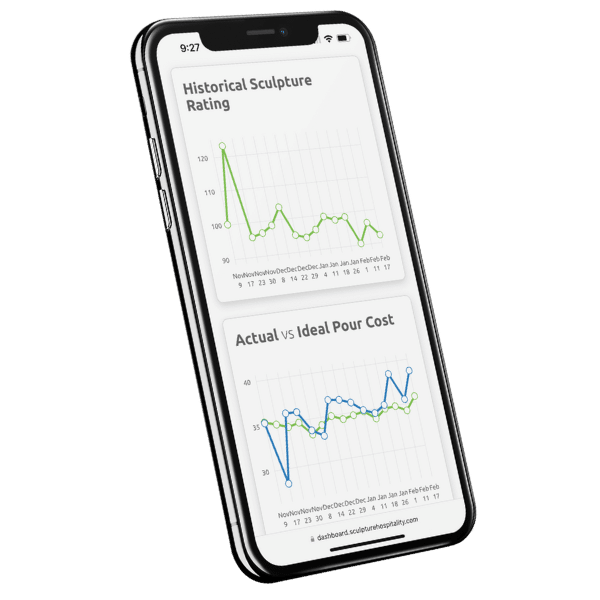
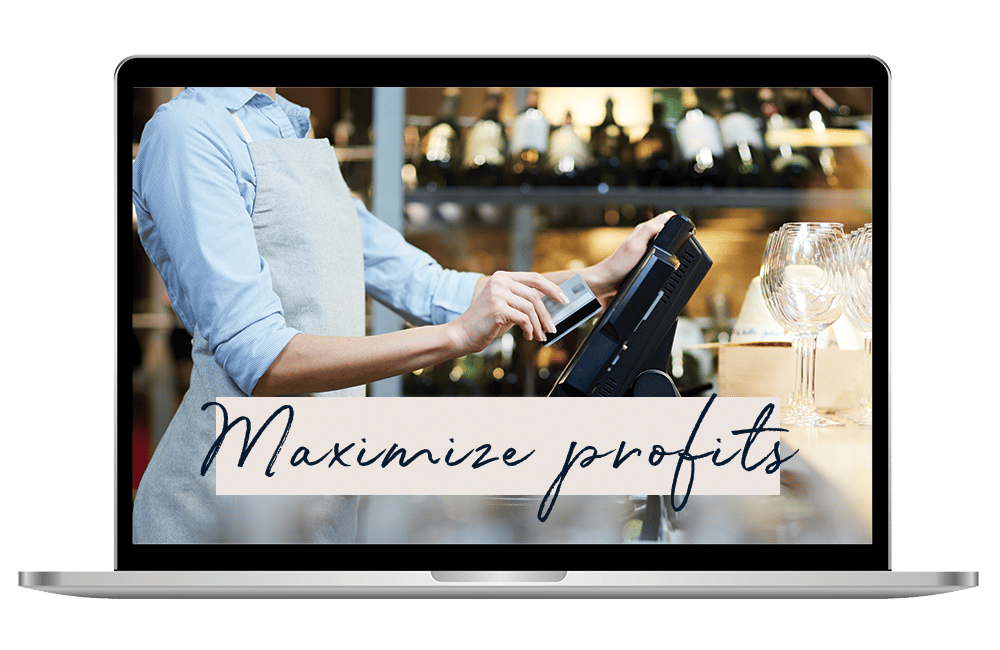
The three costly mistakes you could unknowingly be making?
Find out in this FREE guide and restaurant assessment specifically designed to reveal the unexpected hurdles standing between you and exponential business growth.
Thank You To Our Sponsors
Increase restaurant sales, optimize guest throughput, and boost customer engagement all on one seamless platform.
Request a demo!
Top equipment brands, extensive inventory, everyday low prices, and 60 years serving independent food service operators.
Want to become a podcast sponsor?
Please get in touch with Roger at roger@restaurantrockstars.com
